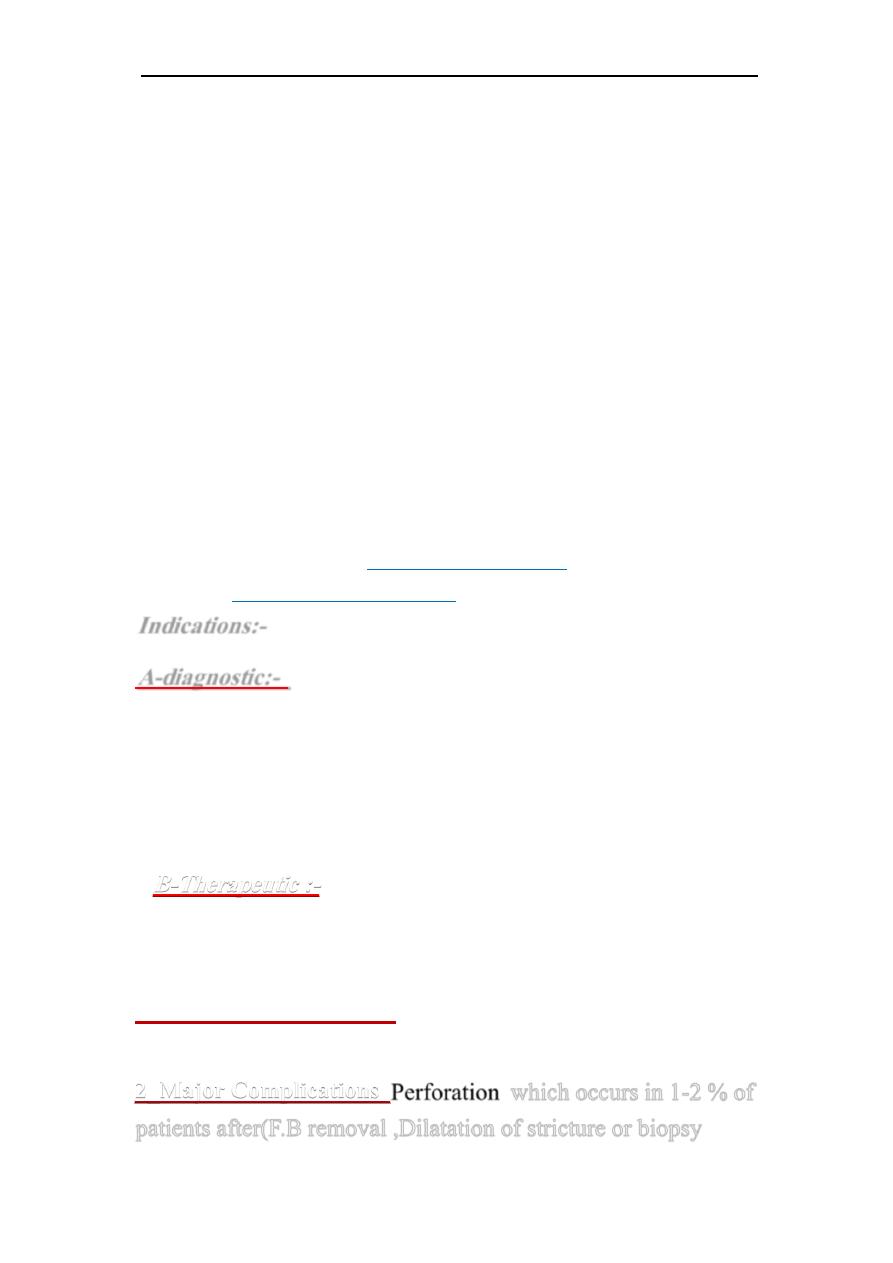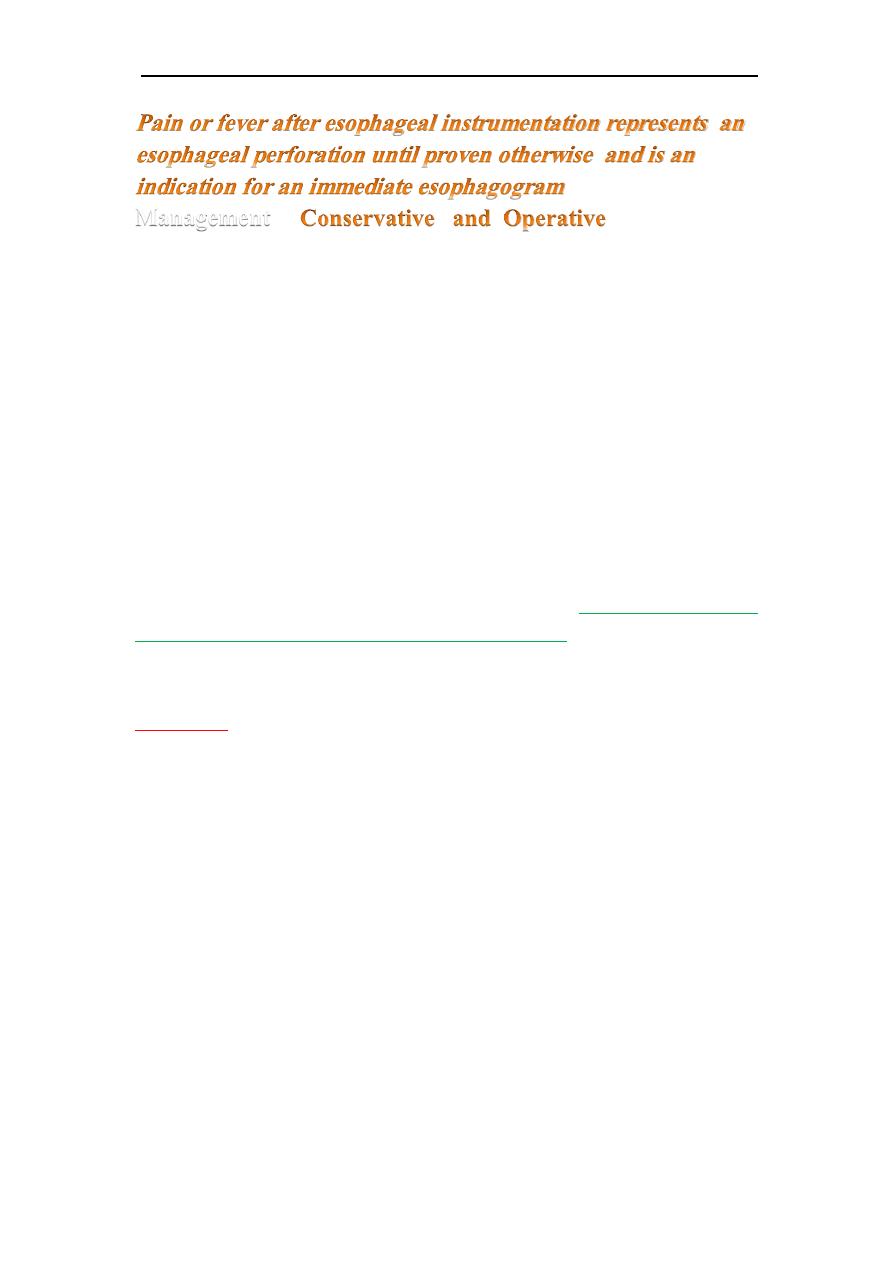
Cardiovascular and Thoracic Surgery Dr.Wallaa AlFalluji
1
The Esophagus
is a long muscular tube approximately 40 cm from the incisor
teeth (25 cm from cricopharyngeus ) ,that extends from the
pharynx at the level of 6
th
. Cervical vertebra to the stomach
,which it joins opposite the body of 11
th
. thoracic vertebra.It is
arbitrary divided into Cervical ,Thoracic and Abdominal parts.
The esophagus has three distinct areas
of naturally occurring
anatomic narrowing :-1-The crico pharyngeal constriction
2-Broncho aortic constriction .
3-The diaphragmatic constriction .
Blood supply :-
Cervical esophagus
Inf.thyroid Ar.
Thoracic esophagus
esophageal branches (Aorta)and segmental
vessels (intercostal & phrenic) .
Venous drainage:-
Cervical esophagus
inferior thyroid &vertebral V.
Thoracic esophagus
azygous & hemi azygous
Abdominal esophagus
gastric veins
Lymphatic
:-
regional lymph nodes ,The flow of the upper 2/3
is upward while the flow of the lower 1/3 is downward.
Nerve supply
:-
the nerve supply to the normal esophagus is
cholinergic and causes contraction every where except for the
circular muscle of the cardia where its adrenergic and causes
relaxation .
Esophageal Hiatus :-
It is a sling of muscle fiber that arises
from the right crus in approximately 45% of the patients ,
however both right and left crus contribute to the hiatus
Physiology :-
It is a muscular tube that begins proximally with
upper esophageal sphincter (UES) and ends distally with lower
esophageal sphincter (LES) .Its function is to transport the
swallowed material from the pharynx down to the stomach

Cardiovascular and Thoracic Surgery Dr.Wallaa AlFalluji
2
Clinical manifestation of esophageal diseases
it include :-
Dysphagia (
difficulty in swallowing) ,
Odynophagia
(pain on swallowing) ,
Regurgitation & vomiting , Drooling of
saliva , Heart burn
(substernal burning sensation ) ,
Weight loss
& cachexia .
Investigations
1-Plain X-Ray chest :-
it show :-
a dilated esophagus
(especially in lateral view )
, in the lung (fluid level )
from the
spill over of the esophageal content ,
radio opaque foreign body
2-Barium swallow
It is very essential and may be diagnostic in
some esophageal diseases such as achalasia of the cardia .
3-Esophagoscopy :
It is the direct visualization of the interior of
, carried under GA
rigid esophagoscope
phagus by either
the eso
,carried under local anesthesia
flexible esophagoscope
or by the
Indications:-
evaluate symptoms of dysphagia &
o
T
-
:
diagnostic
-
A
odynophagia ..etc , To asses established esophageal pathology ,
To define or confirm radiological abnormalities ..etc ,It is of
great value in assessment of post operative problems as
anastomotic stricture ,tumor recurrence ,bleeding and recurrent
GER
f
Dilatation o
Removal of foreign bodies ,
-
Therapeutic :
-
B
stricture ,Placement of endoluminal prosthesis (stent )
,Sclerotherapy
, Lase
r photo coagulation for bleeding or tumor
de bulking
ceration of the lips or tongue ,
La
-
:
Minor Complications
-
1
Fracture or dislodgment of teeth
,
Pharyngeal laceration
% of
2
-
1
which occurs in
Perforation
Major Complications
_
2
patients after(F.B removal ,Dilatation of stricture or biopsy

Cardiovascular and Thoracic Surgery Dr.Wallaa AlFalluji
3
Management
4-Manometry :
It is the classical test to examine (LES) function.Hypertensive
Lower Esophageal Sphincter is seen in achalasia of the cardia
Loss of the tone is seen in pregnancy & alcholism
Disorders of esophageal motility
Functional disorders of the esophagus
Are those conditions that
interfere with the normal act of swallowing or produce
dysphagia without any associated intra – luminal, mural
organic obstruction or extrinsic compression.
Upper esophageal sphincter dysfunction :-
Crico pharyngeal
dysfunction (oro pharyngeal dysphagia ) :-
Symptoms complex
that result when there is a difficulty in propelling liquid or solid
food from the pharynx into the upper esophagus .
Causes :-
Neuro genic
CNS (MS) , vascular (CVA) ,tumors
,trauma
,
Myogenic
myasthenia gravis , inflammatory (poly
myositis)
,
Structural
divertuculum
,
Mechanical
intra or
extra luminal
,
Iatrogenic
surgical or irradiation ,
Gastro
esophageal reflux .
Motor disorders of the body of the esophagus
1-Achlasia of the cardia .
2-Diffuse esophageal spasm & related hyper motility disorders
Achalasia of the cardia
Is a disease entity of unknown etiology Characterized by
absence of peristalsis in the body of the esophagus, a high
resting pressure at the (LES) and failure of this sphincter to
relax in response to swallowing .

Cardiovascular and Thoracic Surgery Dr.Wallaa AlFalluji
4
Etiology :-
attributes to a neuromuscular dysfunction affecting
both the narrowed and the dilated segments of the esophagus
occurs at any age. The highest incidence
-
:
Clinical features
is(25-60) Mostly equal sex incidence or > in female ,The
duration of symptoms (Days to years) ,The onset ,sudden or
insidious .sudden( emotional stress ) ,The symptoms include :-
dysphagia ,Regurgitation ,Pain ,Weight loss &Cachexia
.
Heart burn
,Emotional Disturbance ,Respiratory symptoms ,
air bubble. Visible
Absence of gastric
-
CXR :
-
1
-
:
Diagnosis
Esophagus, Fluid level .
2-Barium Swallow
: Dilated Esophagus ,food residue ,Little
barium passed to the stomach ,Morphological forms : Cork-
Screw,Cucumber ,Tortuous & Sigmoid, Bird s beak appearance
3-Esophagoscopy
:To confirm the diagnosis ,exclude other path
4-Manometry:
Absence of peristalsis(body), high LES pressure
Differential diagnosis:
Diffuse esophageal spasm OR Systemic
sclerosis OR Organic obstruction( stricture , tumors)
Treatment :
1-Medical treatment - adalat , isordil 2-Dilatation
(bougienage) pneumatic or hydrostatic 3-Surgery --
---
Heller’s cardio myotomy
…. Recently -- Laparoscopic cardio
myotomy
Complications of achalasia:-
1- Those related to retention &
stasis ( Retention esophagitis ) 2-Air way obstruction &
repeated chest infection 3-Pre malignant (squamous cell
carcinoma )
Perforation of the esophagus
either by
instrumentation
Esophageal perforation following
-
1
the rigid esophagoscope or by bougienage

Cardiovascular and Thoracic Surgery Dr.Wallaa AlFalluji
5
perforation , Foreign bodies ingestion or blunt and
Traumatic
-
2
penetrating trauma
haave’ s syndrome ) due to the
-
( Boer
Spontaneous rupture
-
3
strain of emesis with or without predisposing disease .
of the normal anatomical constriction are the most
sites
The
of the
2/3
upper
common sites of perforation .The
esophagus will perforate into the rt. Pleural cavity while the
will perforate into the lt. Pleural cavity .
rd
1/3
lower
Pain ,Fever ,Dysphagia ,Cervical pain
:
Clinical manifestations
or crepitation , Dyspnea , Pneumothorax and in severe
cases dyspnea and cyanosis .
:Mediastinal emphysema . Pleural effusion
ray
-
Chest X
alize the site of perforation
can loc
Barium study
),IVF , Nasogasric feeding,
NBM = NPO
(
Medical
;
Treatment
Surgical to close the perforation.
Stricture of the Esophagus
the ingestion of solid or
resulting from
It
:
Caustic Strictures
-
1
liquid caustics most frequently seen in children who have
accidentally swallowed the material or in adult who have
ingested the material for suicidal purposes .
like &
-
included alkaline caustics, acids or acid
The chemicals
household bleaches .Strong alkalis (Na&KOH)
Ranges from(minimal to shock ) . Dyspnea may
:
Symptoms
occur .
ation of the etiological agent ,
Identific
-
:
Management
Administration of the neutralizing agent , Assessment of the
extent of the injury , Early Esophagoscopy ! to determine
whether there is esophageal injury or not , Cortico steroid
decreases the degree of stricture , Antibiotics together with
steroid for (3-6 week ) , Barium –swallow two weeks later to
see if there is stricture or not , Dilatation ( Bougenage) may be
needed after(3-4 weeks) and many patients need regular
dilatation , May need Esophageal replacement .
Esophageal stricture is a premalignant.

Cardiovascular and Thoracic Surgery Dr.Wallaa AlFalluji
6
stricture
Esophageal
-
e:
Reflux Esophagitis and Strictur
-
2
secondary to the reflux of acid or alkaline secretions into the
esophagus caused by esophagogastric incompetence as a result
of hypotensive (LES ) . it is a continuous process of destruction
and healing that may stop at any stage or may progress to
fibrosis ,stricture with the resulting dysphagia.
Low stricture
-
1
-
:
to reflux are of three types
Stricture secondary
occur at the
esophagogastric junction
2- High stricture
occur at higher level ,associated with
barrett
esophagus;
it is an acquired condition in which the squamous
epithelium has been eroded by the damaging effects of GE
reflux and has subsequently been replaced by columnar
junctional epithelium, it is a rare ,but it is PRE MALIGNANT
and the malignancy is adenocarcinoma .
3- long stricture
rarest type ,occur in
postpartum vomiting
.
.
Resection
\
Surgery
-
2
.
Dilatation
\
Bougienage
-
1
:
Treatment
CARCINOMA ESOPHAGUS
Carcinoma of the esophagus is a disease of men between
age (50-70) .Two risk factors:- smoking and high
consumption of alcohol.
Achalasia , Barret esophagus &
Predisposing lesions :
Corrosive stricture
most common
95%
Squamous cell carcinoma >
Pathology
(body) , Primary adenocarcinoma < 1-7% most common of
them is adenocarcinoma arise in Barrett’s esophagus
,Mucoepidermoid &Adenocystic carcinoma.
Spread :
Direct extension
OR Lymphatic to cervical
,mediastinal and sub diaphragmatic OR Blood metastases liver
,lung &bone

Cardiovascular and Thoracic Surgery Dr.Wallaa AlFalluji
7
Clinical manifestations :
Dysphagia ,to solid later to liquid
,Weight loss ,Aspiration pneumonia .Pressure symptoms .
Barium –swallow :
irregular ragged mucosal pattern with
annular luminal narrowing .
Esophagoscopy :
to see the tumor , to take biopsy(tissue
diagnosis) ,and esophageal wash for cytology .
CT with oral contrast
Treatment :
1
-
Chemo-therapy:
little value 2-
Radio-therapy :
useful but it may cause post radiation stricture ,radiation
pneumonitis . 3-
Surgery:
a- palliative
b- Resection - partial gastrectomy ,partial esophagectomy
&gastro esophageal anastomosis (Ivor lewis operation ) through
lapratomy & thoracotomy .
Gastro Oesophageal Reflux Disease (GORD)
Heartburn:-
Mild , intermittent reflux of gastric content into the
esophagus without tissue injury .Common among adult .
GORD
:-
Esophagitis with varying degree of erythema ,
edema & friability of the distal esophageal mucosa .
Aetiology :-
Lower esophageal sphincter (LES ) incompetence ,
Gastric outlet obstruction , 50% of patients have an associated
hiatal hernia , Defective esophageal function (Scleroderma )
Mechanism of Anti –Reflux
……..
1-High resting pressure in the distal esophagus (10-20 mm Hg).
2- the right crus of the diaphragm around the esophago -gastric
junction .
3-The phreno esophageal membrane .
4-The presence of the intra abdominal segment of the esophagus
5-The oblique angle of insertion of the esophagus into the
stomach (angle of His ) .
6-The small diameter of the esophagus entering abruptly into the
large diameter (stomach) Law of Laplace .

Cardiovascular and Thoracic Surgery Dr.Wallaa AlFalluji
8
Clinical features :-
Epigastric or retro sternal pain , after meal or
at night , Pain similar to angina , Reflux of food or gastric
content , occurs with bending , Odyno phagia , Pulmonary
aspiration , nocturnal cough
Diagnosis :-
History and physical examination
,
Barium swallow
,Oesophago gastro dudenoscopy (OGD ) & biopsy ,
Ambulatory 24 hours PH monitoring
,
Esophageal manometry
Treatment:-
1- Medical :-
Weight reduction , Change diet (light
frequent meal ) , Stop smoking , Elevate the head of the bed (4-
5 inches ) , Anti acid , Metoclopromide increase LES pressure
& gastric emptying , H2 receptor blockers , Ranitidine (Zantac ),
Proton pump inhibitor omeprazole.
2- Surgical:-
Indications
:- Failure of medical treatment , Presence of complications
(stricture , respiratory symptoms) ,Patient preference . Surgery
:-Laparoscopic Nissen ‘s fundoplication , Lapratomy
Nissen ‘s fundoplication , Thoracotomy Belsy’s mark 1V
repair
Esophageal hiatal hernia
It is the herniation of the
stomach through the esophageal hiatus of the diaphragm.
Hiatal
Hernia are of two types ;
1-Type 1 axial (sliding H.H.)
is
common , usually insignificant ,in which there is hiatus opening
dilatation and or stretching of phrenoesophageal membrane ,
so that a portion of the fundus will slide upward into the hiatus
.No true sac. In some patients a large pouch can occur producing
abnormal degree of GE reflux . (significant) ..
on but more
less comm
)
esophageal (rolling
-
The Para
-
2
significant ,there is a defect of phreno –esophageal mm. So this
allows protrusion of the peritonium through the fascia (true
hernial sac ) .this will lead to progressive enlargement of the

Cardiovascular and Thoracic Surgery Dr.Wallaa AlFalluji
9
hernia .the entire stomach may herniated. May lead to gastric
volvulus, strangulation and intrathoracic gastric distention.
In which herniation of the cardia well above
.
Combined H.H
the diaphragm in addition to paraesophageal hernia .
colon , small
other organs herniated (
Multiorgan H.H.
intestine) .
Heart burn &Regurgitation
Clinical presentation ;
aggravated by posture Commonly after meal , Dysphagia ,
Aspiration into the chest can occur often awaken the patient
can lead to lung abscess .
eal type (II)
hag
paraesop
is
cipal indication
the prin
Treatment :
H.H. & no indication for repair of type(I) unless severe
reflux.
Medical:-
should started once reflux diagnosed
Surgical :-
Nissen ‘s fundoplication (lapratomy or
laparascopic) , Beksy’s mrak IV repair (Thoracotomy )
Esophageal divertuculae
Are epithelial -lined mucosal
pouches that protrude from the esophageal lumen. Classified
into :-Pharyngo esophageal , Parabronchial (midesophageal) ,
Epiphrenic (Supra diaphragmatic)
Sideropenic Dysphagia
(Plummer-Vinson or Patterson-
Kelly syndrome )
.
Cervical dysphagia in patients with iron
deffiency Anemia ,Usually women over the age of (40) years , It
is pre malignant condition,Treatment dilatation &correction of
anemia
Schatzki s Ring
(Distal esophageal web)
Commonly seen in
patient with a sliding H.H.,appearing as annular strictures
projecting into the lumen.
Mallory-Weiss Syndrome
A history of emesis followed
by either melena or hematemesis ,May occur in pregnancy
,alcoholism, bowel obstruction
